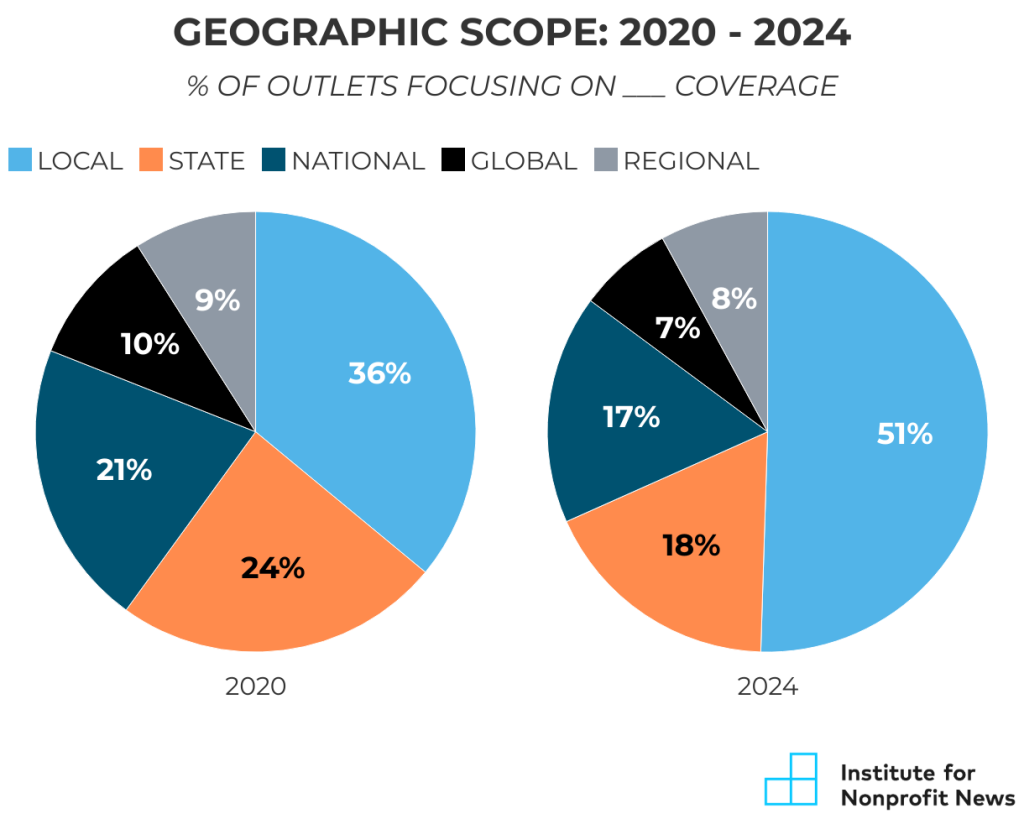Nonprofit local news is growing, but the revenue mix remains unbalanced, according to a new INN report
Nonprofit local news is on the upswing, according to a new report from the Institute for Nonprofit News. An INN survey of nearly 400 digital-first nonprofit news organizations showed that the median outlet raised $532,000 in revenue in 2023, up from $477,000 the previous year. That’s an increase of 11.5%.
In addition, local news organizations now make up 51% of INN’s membership, up from 48% in 2023. The remainder of the projects are regional, statewide and national.
INN is a vitally important organization in the world of local nonprofit news. Through its NewsMatch program, news publishers are able to leverage local donations with matching funds — one-to-one in some cases. The program has raised more than $400 million since 2017. INN’s ethical guidelines have been widely adopted by the nonprofit journalism community. The organization also acts as a fiscal sponsor for fledgling nonprofits that have not yet received IRS approval for full 501(c)(3) recognition.
The new report, “The 2025 INN Index,” was produced by Jesse Holcomb, Michele McLellan and Ha Ta. (A personal note: Ta earned her master’s degree from Northeastern, and she was a student in my graduate ethics seminar during the early COVID days of March and April in 2020.)

One finding that struck me as particularly encouraging was that, as the mix of nonprofit news organizations has tilted to local coverage, the mission has moved increasingly toward reporting on a wide range of issues. As the authors put it:
The share of INN members covering a broad range of topics has increased to 52% last year from 39% in 2018. The share of members focusing on a single topic decreased from 21% in 2028 to 13% in 2024. Other INN members continue to focus on a narrow set of related topics, typically government policy issues.
As Ellen Clegg and I argue in our book, “What Works in Community News,” and in talks that we give, robust local news is a key ingredient for sparking civic engagement — and that requires a focus on the quotidian details of everyday life, such as government meetings, neighborhood issues, public safety, arts and culture, and sports. There are a number of projects that focus on investigative journalism, single topics such as environmental issues, and statehouse coverage, all of which are needed. But the local news crisis was caused by the collapse of community newspapers that had fallen into the hands of corporate chain owners and hedge funds, and that’s the hole that needs to be filled.
Purely local outlets have fewer resource than those with larger coverage areas, the INN report found. The median local newsroom had the equivalent of four full-time employees in 2024, with revenue of just under $360,000. Of course, that doesn’t distinguish between the smallest outlets, some of which are one-person projects covering tiny communities, and those covering larger cities.
One finding that raises some concerns is that nonprofit news organizations still raise about half of their funds — 49% — from foundations, with another 32% coming from individual giving and 18% from earned revenue such as advertising and events. The rule of thumb in nonprofit news is that revenues should be built on a three-legged stool, with income from foundations, individuals and earned revenue each accounting for about one-third.
Still, very few have been able to do that, and the continued reliance on foundations comes amid pressure on those foundations from the Trump White House. As I wrote recently in CommonWealth Beacon, the same foundations that are being asked to make up for the end of government funding for public broadcasting are also a significant source of revenue for community news startups. Local news publishers need to regard national funding as a supplement, not as a primary source of revenue.
At a time when social media is falling apart and Google AI search is depriving news organizations of clicks, newsletters continue to be a source of growth, according to the report. The median number of newsletter subscribers grew from 5,800 to 6,000 between 2024 and 2025, with 78% of purely local outlets reporting increases. Having a direction connection to your audience is crucial.
The use of AI is on the increase, but don’t be too alarmed — it’s most often used for transcribing of summarizing interviews and for analyzing data. Just 6% said they use it for drafting stories, although even that’s too high. I think maybe 0% would be about right.
Hanaa’ Tameez wrote a useful summary of the INN report for Nieman Lab. In addition, we interviewed Sue Cross, the former executive director and CEO of INN, on our “What Works” podcast in June 2023.
